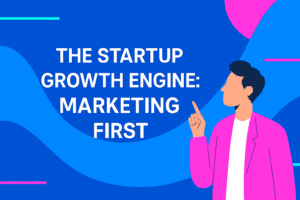Strategies for Reaching Top Decision Makers…
For B2B tech startups, one of the most significant challenges is effectively marketing to C-suite executives. These top decision makers hold the keys to high-value contracts and strategic partnerships, making them a crucial target for B2B tech startups. However, reaching and resonating with this audience is no small feat. Top executives are inundated with marketing messages, pitches and proposals daily, so standing out requires a nuanced approach that goes beyond traditional marketing tactics. B2B tech startups must explore strategies for effectively marketing to the C-suite by addressing the challenges and opportunities that this high-profile audience presents.

Understanding the C-Suite Mindset
Before diving into specific strategies, it’s essential to understand the mindset of C-suite executives. These individuals are focused on the big picture of growth, profitability, innovation and risk management. They are less interested in the technical details of your solution, and many may not fully understand them. This important part of the buying team is more concerned with how any investment will impact their company’s bottom line, competitive advantage and overall strategic goals. They would not usually consider buying a technical solution unless there was total alignment with these considerations. This means marketing messages aimed at the C-suite must speak their language and prioritise real business outcomes over features. You must address the executive’s pain points and align with their broader business objectives.
Top 5 Challenges in Marketing to the C-Suite
Marketing to C-level executives presents several challenges:
1. Self-Centred
The leadership of any company focuses every day on running its business as effectively and efficiently as possible. They have spent years learning their profession and understanding their market. They are desensitised to any product sales outreach that is not relevant to them, their industry or crafted specifically for their company.
2. Time Constrained
Executives are notoriously short on time. They’re calendars are filled weeks and months in advance, and they receive countless daily solicitations from other vendors vying for their attention. This makes it difficult for any single message to grab their attention for any meaningful length of time.
3. Gatekeepers
Executives often have assistants or mid-level managers who filter communications, making it harder to reach them directly.
4. Scepticism
C-level executives can be sceptical of any claims, particularly those that lack specificity, relevance to their industry or fail to demonstrate a clear ROI.
5. Complex Decision Making
Decisions at the top table often involve multiple stakeholders and require a compelling business case that justifies the investment in terms of both time and money.
Top 4 Strategies for Reaching the C-Suite
Given these challenges, B2B tech companies need to employ a combination of targeted, personalised and value-driven strategies to effectively reach C-level executives. There are no silver bullets in marketing, so you will need to deploy as many appropriate tactics as possible to create enough momentum just to get noticed. Use multiple content formats, syndicated via different channels and platforms, to reach them. The same content can be repurposed in different ways to engage the audience and expand your reach.
One of the most effective ways to gain the attention of C-level executives is through higher-value content that tells a relevant story. Executives are constantly looking for new insights and innovative ideas that can drive their business forward. By positioning your company as a relevant thought leader, you can begin to build awareness and trust that you are experts in your domain.
Getting noticed is an important starting point, and by maintaining a consistent presence, you will gain familiarity with your proposition. It takes time, and multiple touchpoints are necessary to allow your message to drip and mature with your audience. This is a long game, so you need patience and consistency. C-suite executives will not be rushed and work to their own timescale and agenda.
Create Thought Leadership in the Following Ways:
- Webinars and Speaking Engagements
Participate in industry events and host your own webinars for executives. Use these opportunities to share your vision and insights, showcasing your company as a leader in the field and your solution as the way to achieve key business outcomes.
- Content Marketing
Publish blogs, eGuides, videos and case studies that provide valuable insights to your target audience. Engage with industry media to provide comment for news and featured articles. Ensure all content is distributed through targeted channels frequented by C-suite executives, either via third parties or directly through email and LinkedIn.
- White Papers and Research Reports
Create quality content that addresses the specific challenges faced by their industry. Offer in-depth analysis and actionable insights that demonstrate your company’s expertise.
2. Tailor Your Messaging
When marketing to C-level executives, consider each individual persona and what motivates them before crafting your message to each. Your communications need to be highly tailored, addressing the specific concerns and priorities of each executive.
Tailored Messages Involve:
- Personalisation
Customise your message to reflect the executive’s industry, company size and unique challenges. Use data, insights and case study examples to craft a narrative that speaks directly to their individual needs. Each executive has their own role and view of the business, which may translate into different pain points and requirements from any solution. These factors must be considered when crafting your message.
- Focus on Business Outcomes
Focus on the results your solution can deliver. Executives care about how your solution can help them achieve their strategic goals, whether that’s increasing revenue, reducing costs, mitigating risk or all the above.
- Case Studies and Testimonials
Provide quantifiable evidence of how your solution has successfully impacted similar companies. Use real-world examples to build credibility and demonstrate the tangible benefits of your offering. Quantifiable outcomes of what similar companies have achieved using your solution can be a powerful way to tell a story and frame your proposition.
3. Use Multichannel Engagement
C-level executives are active across various channels and reaching them requires a multilayered approach.
Use the Following Channels:
- Email
While email is a crowded space, it can still be effective if used correctly. Focus on sending concise, personalised one-to-one emails that highlight the key business outcomes of your solution. Avoid generic pitches and ensure your subject lines are on point.
- Direct Mail
Physical mail still has a place in the digital age and can help you stand out as a differentiator. If you sell a high-value solution, sending high-quality, personalised packages that deliver value, such as a custom report, can attract attention when other channels more easily fail to reach their target.
- Executive Roundtable and Private Events
Hosting and attending exclusive events, such as roundtable discussions for C-suite executives, provides a more intimate setting for deeper engagement. Small and specialist conferences also offer a more intimate experience, with a good opportunity to build personal relationships and showcase your company’s value. These events can be effective for this audience, as they provide the opportunity to engage directly and learn more about prospects and their challenges.
- LinkedIn
LinkedIn is the go-to platform for professionals, including C-suite executives, so don’t ignore this channel, but be mindful of how use it. Use LinkedIn’s targeting capabilities to deliver messaging to the right people. Sharing content and connecting with executives to build your network can be useful. Don’t just jump straight in and start direct messaging CEOs; take your time and have a longer-term approach for engaging them by building brand awareness with meaningful content.
4. Build Trust and Credibility
Trust is a critical factor in the decision-making process for C-suite executives. Building trust takes time and involves more than just delivering a compelling sales pitch; it requires demonstrating reliability, transparency and a commitment to helping them achieve their business goals. Wearing a branded polo shirt or hoodie to a prospect meeting does nothing to impress a company executive, so don’t do it.
How You Build Trust:
- Provide References and Case Studies
Executives want to see how the same type of companies are solving the same challenges they have. Offer references from other companies or executives who have benefited from your solution. Detailed case studies that outline the problem, solution and results are a great way to show how you add value and can be a persuasive sales aid.
- Transparency in Communication
Be upfront about your capabilities, pricing and potential challenges. Executives appreciate honesty and are more likely to trust a company that speaks clearly about its offerings. Stay focused on your proposition and what your solution can deliver today. Avoid being drawn into the art of the possible during sales conversations and never make promises you cannot keep.
- Long-Term Partnership
Position your company as a partner for the future rather than a vendor seeking a transactional relationship. Highlight your commitment to supporting the executive’s business over the long term, whether through ongoing services, support, continuous improvement and innovation.
Win the C-Suite and Win Big
Marketing to the C-suite is a challenging but rewarding endeavour. B2B tech startups that successfully reach and resonate with C-level executives can unlock significant opportunities for growth and innovation. Remember, the key to success lies in understanding the unique needs and priorities of the individual personas involved and delivering a value proposition that aligns with their strategic goals. Make sure you wear smart business attire when meeting them, not a low-rent branded hoodie that looks like you walked in off the street. Businesspeople like to buy from other businesspeople, so look and act like one.
You may want to read: “Why Marketing is the Tech Startup Growth Engine.”







